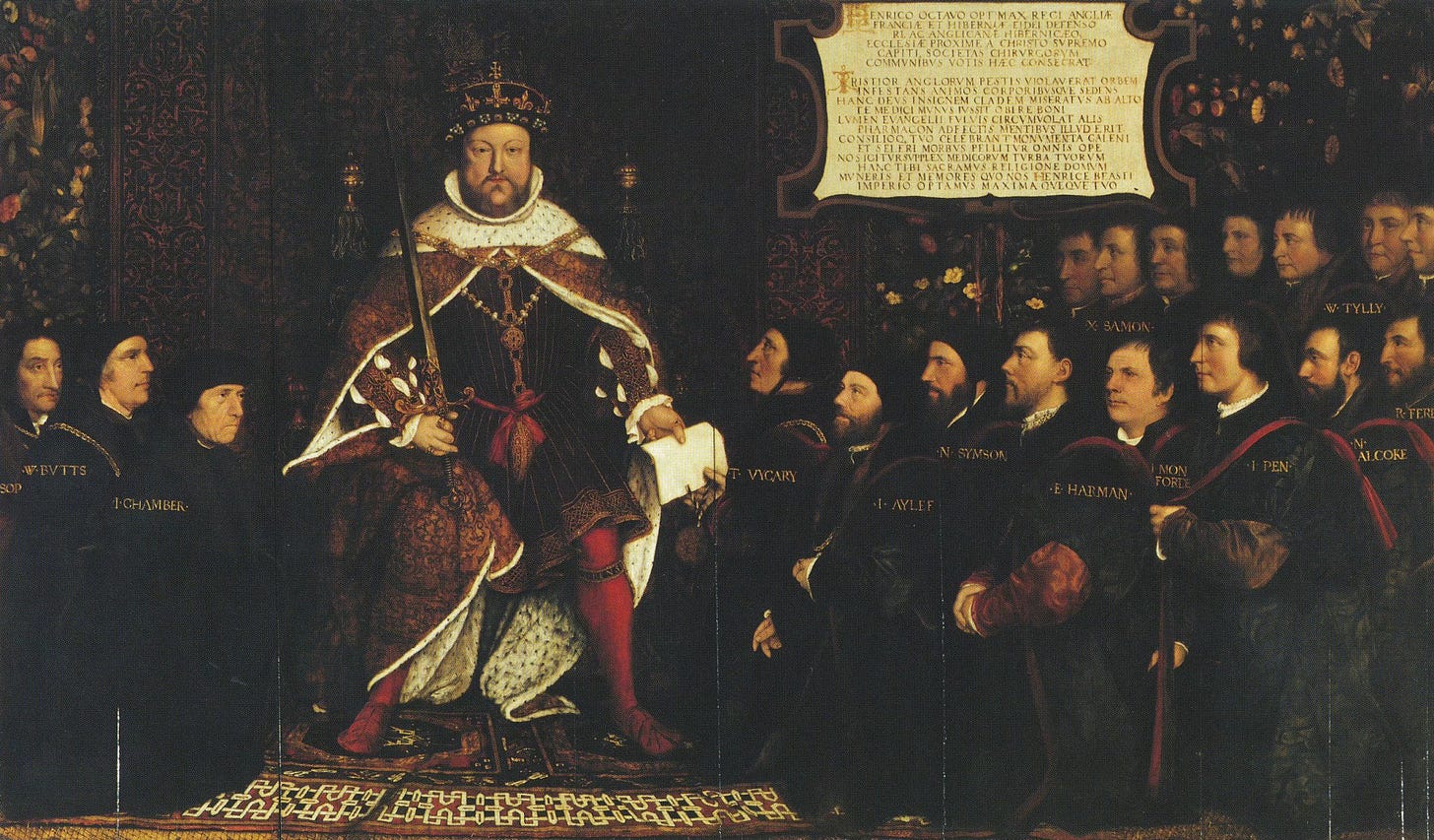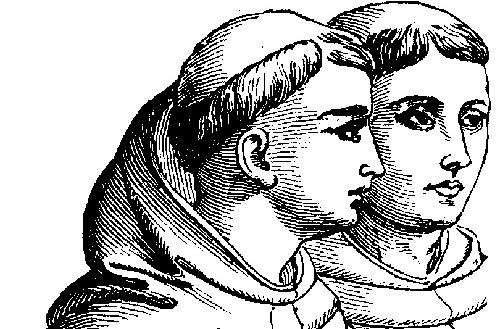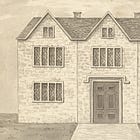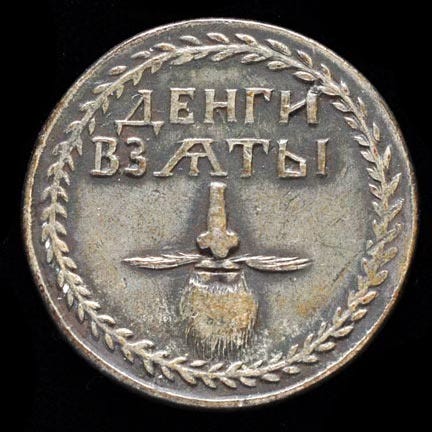A history of… shaving (Part 2)
At the start of the 12th century having a beard was said to have made you as filthily lascivious as a goat…
(I had originally intended this to be a two-parter, but due to the – to me at least – fascinating religious significance of beards in medieval Europe there was too much good stuff that I couldn’t bring myself to cut, so it will be an unprecedented three-parter)1
In my last piece I explored the history of shaving up until around the year 0; this piece will cover the next two thousand years of hair-removal history. Early Christianity inherited no direct law about hair, but Church Fathers quickly developed views linking facial hair to piety, nature, and masculinity. Clement of Alexandria (c.150–c.215) was, I think it fair to say, very much in the pro-beard camp, in no small measure due to the similarity it gave men to lions:
[God] has adorned man, like the lions, with a beard, and endowed him… with shaggy breasts—a sign of strength and rule… This, then, the mark of the man, the beard, by which he is seen to be a man…
He wasn’t a fan, however, of hair on the top of the head (unless, and no, I have no idea why, it was curly):
About the hair, the following seems right. Let the head of men be shaven, unless it has curly hair. But let the chin have the hair. … For an ample beard suffices for men. And if one, too, shaves a part of his beard, it must not be made entirely bare, for this is a disgraceful sight. The shaving of the chin to the skin is reprehensible, approaching to plucking out the hair and smoothing. … the hair of the moustache … is to be cut round, not by the razor, … But the hair on the chin is not to be disturbed, as it gives no trouble, and lends to the face dignity and paternal terror.
This may all seem, to our modern eyes, both somewhat odd, and somewhat amusing, but for men at the time these views had a significant impact upon their daily lives – if a significant figure in your religion told you that you had to have a beard then you were pretty likely to have one. It wasn’t just Clement putting the barbers out of business. The Latin theologian Tertullian shared his stance, criticising men who meticulously trimmed or styled their beards, equating such vanity with female folly: “to cut the beard too sharply…to shave round about [the mouth]…all these things are frivolous, hostile to modesty”. Cementing the pro-beard consensus was the great St Augustine, who taught that “the beard signifies the courageous; the beard distinguishes the grown men, the earnest, the active, the vigorous”.
In time, however, things began to change, but not universally, and beards became an increasingly significant issue as the Christian church fragmented into different, often competing, traditions. In certain ascetic circles, shaving one’s head or face became a mark of humility. The tonsure – the practice of clerics or monks shaving part of the head – emerged in early monasticism as a symbol of renunciation of worldly vanity. During the medieval era, Western Europe reversed the patristic pro-beard bias. The Latin Church increasingly associated clerical celibacy and purity with a clean-shaven face, in contrast to the laity. The sixth-century Fourth Council of Carthage notably decreed in Latin, “Clericus nec comam nutriat nec barbam”, which translates as “A cleric should neither let his hair grow long nor [grow] a beard.” This rule, widely repeated in canon law collections, set a precedent: throughout the Middle Ages.
The Greek East, however, maintained the older, bearded, tradition, in clear contrast to the church in the West. This divergence became so sharp that hair became a point of polemical contention between Eastern Orthodox and Roman Catholic Christians. In the 11th-century Great Schism, Greeks mocked the Latins’ bare faces as an innovation against apostolic custom, while Latins accused Greeks of unkempt appearance. In one Eastern polemic, the shaven face was deemed “a departure from the sacred and holy” – the Old Believers of Russia in the 17th century even claimed that shaving the beard could invite moral depravity.
By the High Middle Ages, nearly all Western monks and priests were clean-shaven under their tonsured crowns – an image of self-denial and uniformity. In monastic rules, barbers held an important place: a designated barber-monk would periodically shave the brethren. There are even records of liturgical ceremonies for the first shave of a novice monk.2 In several medieval pontificals and monastic ordines, a rite ‘Ad barbam tondendam’ (‘for shaving the beard’) accompanied a monk’s first shave, with prayers framing the act as an offering of the ‘first-fruits of youth’ and invoking Psalm 132 (Ecce quam bonum)—in some books the abbot is directed ‘here the abbot shaves the beard’.
At the start of the second millennium the laity of Western Europe were often beard-free (particularly the elite classes who had both the time and the money to shave) but there were some variations. Among the most notable of these can be seen the Bayeux Tapestry (documenting the Norman invasion of England) – the English shown as moustachioed (and often with long hair)3 while the Normans were short-haired and clean shaven.
Soon afterwards beards had something of a resurgence, particularly among the nobles. It was said that before the battle of Antioch (1096) the crusaders “suffered their beards to grow” as an act of penitence (and also probably because they had been exposed to Eastern Christian traditions on their journeys to the Holy Land).4 Bearded upon their return home it became cool to ape their appearance, but the church was having none of it. In around 1105 Bishop Serlo of Sées preached before Henry I at Carentan about the evils of being overly hirsute and then physically cut the hair of both the king and his courtiers. I think that it is fair to say that he had pretty strong views on the subject:
It is not for their ornament or pleasure that penitents are enjoined not to shave their beards or cut their hair; but that, as their sins make them appear inwardly rough and unseemly in the sight of God, so they may in their exterior exhibit themselves before men unshaven and unshorn, and mark the deformity of the inner man by their outward ignominy. By their long beards they make themselves like goats, whose filthy lasciviousness is shamefully imitated by fornicators and sodomites, while good men justly treat them with abhorrence on account of the odious foulness of their lusts. As for those who nourish their hair, they are considered as fit associates of the women by whose blandishments they are seduced from manly virtue to evil courses, and very often involved in the wretchedness of a detestable apostacy.5
Not one to be timid of hyperbole, he went on to suggest that beards are forerunners of the apocalypse:
They suffer their beards to grow for fear that if they shaved, the short bristles might prick the faces of their mistresses when they were kissing them, and are so hairy that they look like Turks rather than Christians. Thus the personal neglect which is the mark of penitence is converted into a token of wantonness! In short these forward sons of Beliai dress their hair like women, while they wear things like scorpions’ tails at the extremities of their feet,6 thus exhibiting themselves as women by their effeminacy, and serpents by their pointed fangs. This kind of men were foretold a thousand years ago by St. John the mystic, under the figure of locusts, and he has plainly foreshadowed them in the Apocalypse, written in the isle of Pathmoth. Many persons adopt this perverted practice from ignorance that there can be so much mischief in the fashion of wearing the hair in which they glory. For this reason, I beseech you, most illustrious king, to set your subjects a laudable example, that they may see in your person, above all others, how they ought to adjust their own.
Most people, of course, didn’t have a bishop to shave them but luckily for them many monastic barbers transitioned into being lay professionals, willing to do the job for the small fee. By the later Middle Ages, many barbers in European towns performed a dual role as “barber-surgeons”, providing grooming and medical bleeding or wound care. In an era before physicians were accessible to most, the barber-surgeon was the community’s all-purpose practitioner for surface ailments – lancing boils, extracting teeth, setting minor fractures – as well as cutting hair and shaving beards. They used razors not only on faces but to open veins (bloodletting), which gave them surgical credibility. The red-and-white (and sometimes also blue) barber’s pole, still a symbol of the trade, purportedly represents blood and bandages of this once-common practice.7
By the 14th and 15th centuries, urban barbers had organised into guilds across Europe, their profession straddling hygiene and healing. Guild statutes regulated training: a would-be barber-surgeon typically served a long apprenticeship (often seven years minimum)8 under a master. For example, the barber-surgeons’ ordinances of Norwich (1605) required that any apprentice “use the mystery of barbours or surgery” for seven years at least before he could be examined and “allowed” by the guild’s wardens and the city authorities. After such apprenticeship and passing a test (sometimes an oral examination or presenting an “example of work”),9 the trainee gained his freedom to practice as a master barber-surgeon. Guilds enforced standards of competency and behavior, inspecting members’ shops and punishing malpractice. They also jealously guarded their privileges – for instance, prohibiting unlicensed “foreign” barbers from plying the trade in town. In London, the Worshipful Company of Barbers existed by 1308, and barbers were numerous in every city quarter. In 1540 King Henry VIII granted a landmark charter merging the Barbers’ Company with the Surgeons’ Fellowship into the unified Company of Barber-Surgeons. This pact – even commemorated by a painting of Henry VIII inspecting the guild’s members – acknowledged that barbers and surgeons often overlapped in practice. (It also allowed surgeons to perform anatomies on executed felons, and barbers to continue minor surgeries, illustrating a trade hierarchy.)

During the Reformation (16th century), facial hair took on new religious overtones. The reformer Martin Luther grew a great beard (initially while in hiding as “Junker Jörg”), and Protestant leaders like John Calvin and John Knox wore beards in deliberate contrast to clean-shaven Roman priests. This prompted Catholics to double-down on their no-beard rules for clergy. In 1560 the Council of Trent’s disciplinarian, St Charles Borromeo, even issued a pastoral letter De barbâ radendâ (“On shaving the beard”) exhorting priests to obey the old canons and shave. One French Catholic satirist of the era lampooned Calvinists as “poètes à longue barbe” (“long-bearded prophets”), conflating heresy with unkempt whiskers. Thus by 1600, beards in Europe were simultaneously a theological statement, a fashion choice, and a subject of medical belief (some physicians claimed a thick beard helped filter bad air and preserve health). Society’s attitudes toward facial hair were complex: a flowing beard could signify wisdom and dignity (as seen in portraits of philosophers or biblical patriarchs), yet excess facial hair on a common man might be deemed uncouth or even seditious (authorities feared rebels and bandits who hid behind big beards).
Beards, were in some instances, so contentious that laws were put into place to control, or at least monetise, their existence. It is sometimes claimed that Henry VIII placed a tax on beards, but this appears to be somewhat spurious (likewise the claim that Elizabeth I did the same). One royal who definitely was strongly anti-beard was Peter the Great of Russia. Having spent time in Europe on what one might call an elongated study tour (in which he studied shipbuilding, and err, destroyed John Evelyn’s garden – see link below!) he returned set on westernising his country. For him beards were symbols of outdated customs and he wanted to bring his peoples into the modern, clean-shaven world. Returning home in 1698 he publicly cut the beards of boyars (the highest rank of Russian nobility) and required his courtiers to be clean-shaven.
While this undoubtedly reduced the number of beards in his immediate environment, it wasn’t enough to achieve his goal of making Russia a beard-free country. To that end on the 16th January 1705 he passed an ukaz (a formal degree) placing a tax on beards (earlier laws were also passed, but they have not survived):
…чтобъ впредь съ сего Его Великаго Государя указа, бороды и усы брили. А буде кто… брить не похотят… съ техъ имать… по 60 рублей… съ Гостей… первыя статьи — по 100 рублей… по 30 рублей съ московских жителей… А крестьянам… по 1 копейке с бороды при въезде в город
Henceforth, by His Majesty’s decree, beards and moustaches are to be shaved. Anyone who refuses must pay a duty: 60 rubles; from first-rank ‘Guest’ merchants, 100 rubles; 30 rubles from Moscow residents; and from peasants, 1 kopek per beard each time they enter a town.10
Some groups were except, such as members of the orthodox clergy (who were very unhappy about this tax, see earlier for their views on shaving) and it seems to have been pretty effective at removing the facial hair of the urban middle classes. After paying your tax you were given a copper token that you had you carry with you at all times so that you could prove, if challenged, that you had paid to have your beard! The tax was simplified to a flat-rate of 50 roubles per person in 1715 and, astonishingly, was only formally repealed in 1772 by Catherine the Great.
In my next piece I will (finally!) bring the story of shaving up to the modern day, but to end I’ll share (as trailed in the last piece) a little about the shaving habits of one Samuel Pepys. The great diarist adopted, for a while at least, a method of shaving I have never come across before – rubbing his face with a piece of pumice stone. We know this from three entries in his diary:
To trimming myself, which I have this week done every morning, with a pumice stone,—[Shaving with pumice stone.]—which I learnt of Mr. Marsh,11 when I was last at Portsmouth; and I find it very easy, speedy, and cleanly, and shall continue the practice of it.”
— 25 May 1662.“I did also in a suddaine fit cut off all my beard, which I had been a great while bringing up, only that I may with my pumice-stone do my whole face, as I now do my chin, and to save time, which I find a very easy way and gentile.”
— 31 May 1662.…the barber came and trimmed me (I having him now to come to me again after I have used a pumice-stone a good while, not but what I like this where I cannot conveniently have a barber, but here I cannot keep my hair dry without one)…”
— 14 September 1662.
You, may like, me, be wondering how on earth one can shave with a piece of rock. The answer is seems is that the rough surface of the stone would literally abrade away the hair growing through the skin. It would only work on short stubble, and personally I’d worry about what it did to the skin itself, but Pepys was clearly a fan, so it can’t have been that bad!
I realise that this piece has a significant western European bias, but I thought that it made sense to try and cover one area reasonably well, rather than many superficially.
This interestingly mirrors the Roman practice of celebrating the depositio barbae which I mentioned in my last piece.
Which is, as we saw last time, is how Julius Caesar described the ancient Britons.
It is also possible that beards were a means of hiding quite how emaciated they were from their enemies.
He was however cool with women having long hair, saying “If a man have long hair it is a shame unto him; but if a woman have long hair, it is a glory to her, for her hair is given her for a covering”
I think that at this point he is taking offence at men wearing those pointy, medieval, shoes that have up-turned toes. I think.
It certainly seems as those these were pretty common around 1700, and it is probable that the red is representing blood, but there isn’t definitive evidence. There is a lot more I could add about this but I am already over my word-limit.
It seems astonishing to me that this is the same period of time that it takes to train a doctor today when there is clearly a lot more stuff to learn now.
I guess this meant shaving someone?
This is not a literal translation, rather am more interpretive one that maintains the content but is a smoother read.
Capt. Richard Marsh, a senior Board of Ordnance official. He was from a prominent Limehouse family and served as Storekeeper of the Ordnance (pre–Civil War, and again 1660–1672).





